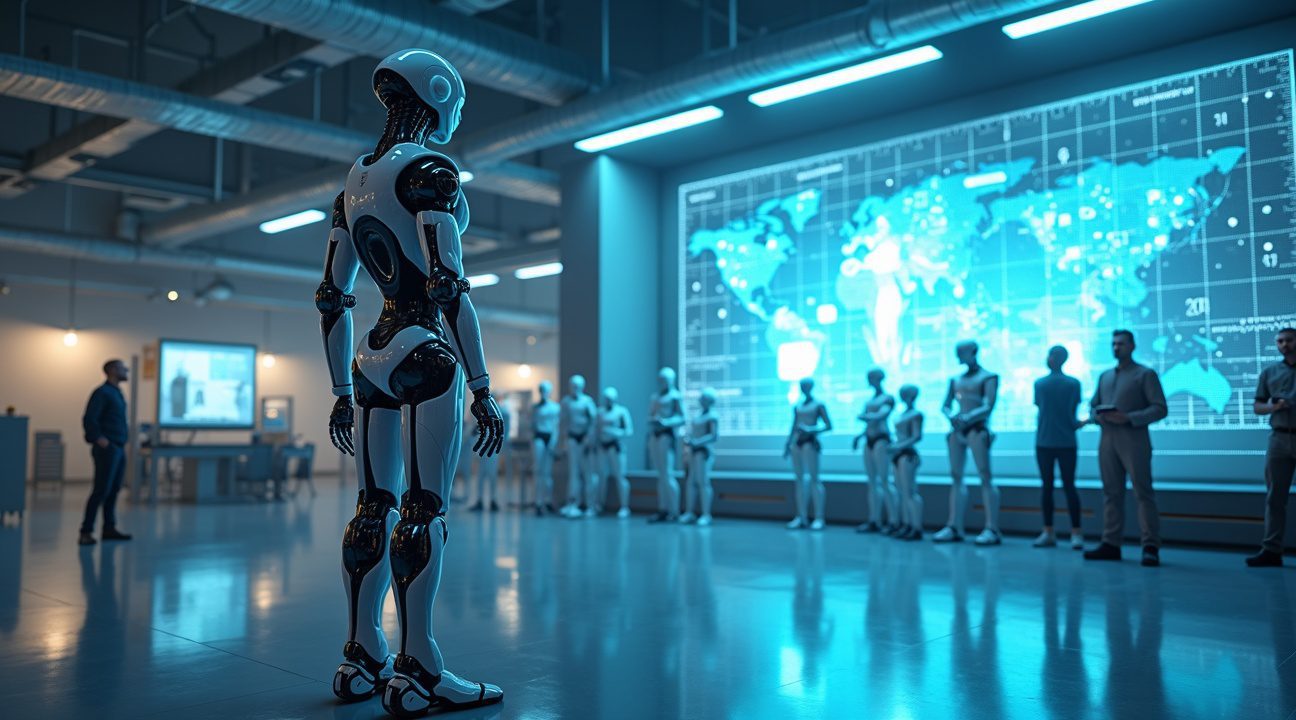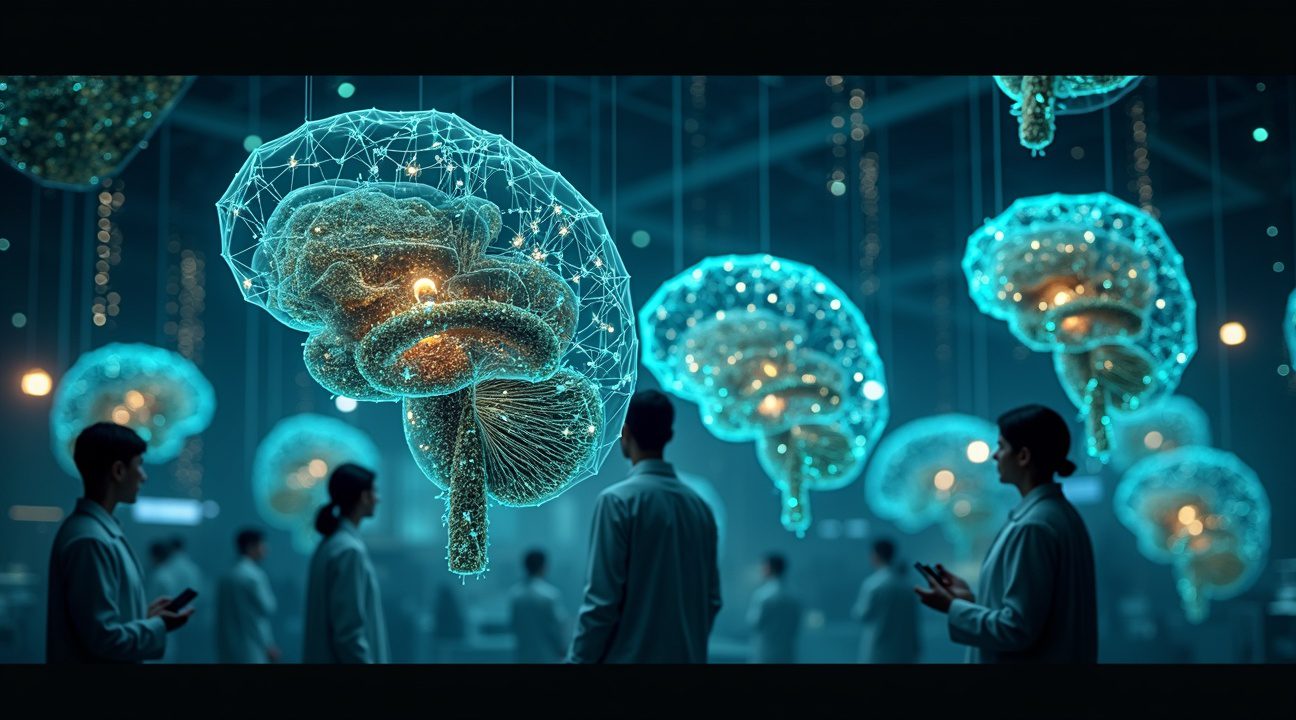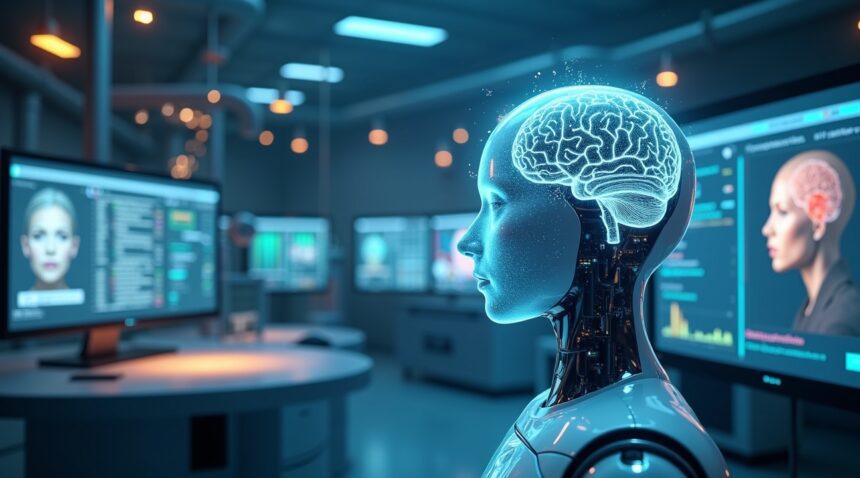Elon Musk has unveiled a bold vision for humanity’s digital future, proposing that within the next two decades, people could upload their consciousness into robots—creating a form of digital immortality through Neuralink and Tesla’s Optimus humanoid robots.
Key Takeaways
- Musk’s vision relies on integrating Neuralink’s brain-computer interface (BCI) with Tesla’s Optimus robots, aiming to merge digital consciousness with advanced humanoid platforms.
- Current BCI technologies are limited in scope, managing simple motor functions and neural signals, but are far from achieving full mind mapping or transfer.
- Numerous companies are developing competing humanoid robots, including Agibot’s A2 series and the Astribot S1, creating a competitive landscape for mind-hosting platforms.
- Breakthroughs in biocomputing using lab-grown brain organoids are offering new pathways to understanding cognition and may significantly aid consciousness uploading research.
- Philosophical and ethical questions still challenge the concept of digital mind transfer, particularly issues surrounding identity, personal continuity, and data security.
The Core Technologies Involved
Neuralink
Neuralink is a brain-implant startup co-founded by Elon Musk. Its goal is to create direct communication between the human brain and computers. The implant, a coin-sized chip, is designed to record brain signals and potentially stimulate neural activity. The current focus is on medical applications, such as restoring mobility to paralyzed individuals, but Musk envisions its long-term use in uploading consciousness.
Tesla’s Optimus Humanoid Robot
Optimus is a humanoid robot being developed by Tesla to perform general tasks and assist in both industrial and domestic tasks. Optimus may eventually serve as the physical host for uploaded human consciousness. By combining Neuralink’s brain interface with Optimus, Musk believes that the line between human and robot could blur dramatically.
Philosophical Implications
A major unresolved issue in digital immortality is whether an uploaded mind would still be “you” or a digital replica. Philosophers question if continuity of ego and identity would remain intact, or if such a copy merely mimics human traits. These questions touch on the essence of what it means to be human.
Related Reading
For a deeper dive into how Neuralink interfaces with the brain, visit the official Neuralink website. To explore more about human-robot symbiosis, you can also learn about Tesla’s ambitions with AI and Optimus here.
Consciousness Transfer Within Two Decades: Musk’s Digital Immortality Timeline
Elon Musk’s latest prediction suggests that humans might achieve digital immortality within the next 20 years through consciousness transfer technology. This ambitious timeline centers on uploading human memories, identity, and consciousness into digital formats, essentially preserving individuals beyond their biological lifespan.
The vision involves a sophisticated merger between two of Musk’s companies: Neuralink’s brain-computer interface technology and Tesla’s Optimus humanoid robot. By combining these innovations, Musk’s technological empire could potentially create digital replicas of individuals housed within robotic bodies.
The Technology Behind Digital Consciousness
Neuralink’s brain-machine interface serves as the foundation for this futuristic concept. The company’s neural implant technology aims to decode and record brain activity, capturing the electrical patterns that constitute thoughts, memories, and personality traits. This brain–machine interface would theoretically map an individual’s complete neural network, creating a comprehensive digital blueprint of their consciousness.
Tesla’s Optimus robot provides the physical vessel for this transferred consciousness. The humanoid design ensures that uploaded minds can interact with the physical world in a familiar way, maintaining human-like movement and capabilities. This combination addresses both the software and hardware requirements for mind uploading technology.
The process involves several critical steps that researchers and engineers must perfect:
- Neural pattern recognition and recording through advanced brain-computer interfaces
- Data storage systems capable of handling massive amounts of consciousness-related information
- Processing power sufficient to run complex human consciousness simulations
- Integration protocols that allow digital minds to control robotic bodies seamlessly
- Memory preservation techniques that maintain personal identity and experiences
Current Neuralink trials focus on helping paralyzed patients control computers through thought alone, demonstrating early success in brain-computer communication. These experiments provide crucial groundwork for more complex consciousness transfer applications.
The concept of digital immortality differs significantly from biological life extension. Rather than preventing physical death, this technology would create a digital continuation of individual identity and memory. The uploaded consciousness would theoretically retain all personal experiences, relationships, and knowledge while gaining the advantages of a robotic body, including enhanced durability and potentially unlimited operational time.
Technical challenges remain substantial. Scientists still debate the fundamental nature of consciousness itself, making it difficult to determine what exactly needs transfer for true digital immortality. The human brain contains approximately 86 billion neurons with trillions of connections, creating an incredibly complex system that current technology can’t fully map or replicate.
Artificial intelligence advances play a crucial role in making consciousness transfer feasible. Machine learning algorithms must interpret brain signals, compress consciousness data efficiently, and maintain the continuity of digital minds once transferred. These AI systems would essentially serve as the operating system for uploaded human consciousness.
Storage requirements present another significant hurdle. A complete human consciousness might require exabytes of data storage, far exceeding current consumer technology capabilities. However, advances in quantum computing and data compression could make this technically achievable within Musk’s proposed timeline.
The 20-year prediction aligns with Musk’s other ambitious projects, including Mars colonization efforts. Digital immortality could prove especially valuable for space exploration, allowing human consciousness to survive the harsh conditions of interplanetary travel without requiring life support systems.
Legal and ethical frameworks will need comprehensive development before consciousness transfer becomes reality. Questions about digital rights, identity verification, and the legal status of uploaded minds require careful consideration by lawmakers and ethicists.
Despite the challenges, Musk’s track record with revolutionary technologies lends credibility to his timeline. His companies have successfully developed electric vehicles, private space travel, and neural implant technology, demonstrating an ability to transform ambitious concepts into working prototypes.
https://www.youtube.com/watch?v=O2uW5ZGzJZQ
Neuralink’s Current Capabilities vs. Future Mind Upload Ambitions
I’ve been closely following Neuralink’s development since its inception, and the gap between current capabilities and Musk’s consciousness upload predictions remains substantial. The company’s brain-computer interface technology currently operates within a remarkably narrow scope compared to the ambitious future scenarios being discussed.
Right now, Neuralink focuses primarily on medical applications, particularly helping paralyzed patients regain mobility through direct neural control of external devices. The implantable brain chips successfully record neural activity and translate these signals into commands for computers and robotic limbs. Human trials have shown promising results for basic motor function restoration, but this represents just a fraction of what would be required for full consciousness transfer.
The technology works by reading electrical signals from specific brain regions associated with movement intention. These signals get processed and converted into digital commands that can control cursors, keyboards, or prosthetic devices. However, capturing the complete spectrum of human consciousness would require monitoring and interpreting vastly more complex neural networks spread throughout the entire brain.
The Enormous Technical Gap
Current brain-computer interface capabilities pale in comparison to what consciousness uploading would demand. Consider these technical challenges that separate today’s achievements from future mind upload ambitions:
- Reading and interpreting the estimated 86 billion neurons in the human brain simultaneously
- Understanding how memories form, store, and interconnect across different brain regions
- Capturing personality traits, emotional responses, and subjective experiences
- Developing sufficient computational power to process and store this massive data volume
- Creating algorithms that can accurately translate biological neural patterns into digital formats
Musk has suggested that future iterations might enable memory downloads and mental state transfers to artificial intelligence systems or humanoid robots. Yet even he acknowledges that any resulting digital twin wouldn’t constitute an exact replica of the original person. The subtle nuances of human consciousness, including the subjective experience of being “you,” remain poorly understood by neuroscience.
Brain-to-cloud connectivity represents another ambitious goal that extends far beyond current capabilities. While Neuralink’s chips can transmit basic motor signals wirelessly, uploading entire consciousness would require bandwidth and processing power that doesn’t yet exist. The human brain processes information at approximately 20 watts of power while generating roughly 20 petabytes of data daily.
I find it important to note that consciousness itself remains one of science’s greatest mysteries. Researchers still debate whether consciousness emerges from specific neural structures, quantum processes, or complex interactions between multiple brain systems. Without fully understanding consciousness at a biological level, replicating it digitally becomes exponentially more challenging.
The medical applications currently pursued by Neuralink serve as crucial stepping stones. Each advancement in reading neural signals, interpreting brain activity, and establishing stable brain-computer connections contributes valuable knowledge. However, the leap from restoring basic motor function to uploading complete consciousness represents a quantum jump in complexity.
Elon Musk’s ambitious timelines often push boundaries and drive innovation, but the 20-year prediction for consciousness uploading appears optimistic given current technological limitations. The fundamental challenges involve not just engineering problems but also philosophical questions about the nature of identity, consciousness, and what it truly means to be human.
Nevertheless, the progress being made with brain-computer interfaces shouldn’t be underestimated. Each breakthrough in neural signal interpretation and brain-machine communication brings us closer to understanding how our minds work. Whether this ultimately leads to consciousness uploading or simply enhanced human capabilities remains to be seen, but the journey itself continues to push the boundaries of what’s possible in neurotechnology.

Tesla Optimus and the Race for Humanoid Robot Bodies
Tesla’s ambitious Optimus project represents a critical stepping stone in Musk’s vision of consciousness uploading, as these humanoid robots could serve as the physical vessels for human minds. I believe the development timeline is particularly aggressive, with Tesla targeting operational deployment within their factories by 2025 and consumer availability by 2026. This rapid progression demonstrates the urgency behind creating suitable robotic platforms that could eventually house human consciousness.
The training methodology for Optimus relies heavily on motion capture technology, allowing the robot to learn and replicate human movements with increasing precision. I find this approach especially significant because it mirrors how uploaded human consciousness might need to adapt to controlling a robotic body rather than biological limbs. The motion capture training essentially creates a bridge between human movement patterns and robotic execution, potentially serving as a foundation for consciousness-robot integration.
The Competitive Landscape
Several formidable competitors are racing to develop humanoid platforms that could serve similar purposes. The competition includes these notable contenders:
- The Agibot Expedition A2 and A2 Max from Zhiyuan Robot target manufacturing and industrial applications, with the A2 Max featuring an impressive 67 degrees of freedom and thrust capabilities up to 8,800N.
- The Astribot S1 from Stardust Intelligence focuses on domestic and personal assistant roles, incorporating autonomous adaptation and imitation learning technologies.
- The standard Agibot A2 matches human proportions at 5’6″ tall and 150 pounds, while offering 40 degrees of freedom for complex task execution.
These competing platforms highlight different approaches to humanoid robotics, from industrial strength to domestic functionality. I see the diversity in design philosophies as beneficial for eventual consciousness uploading applications, as different robotic bodies might suit different human personalities or intended activities.
The race extends beyond mere physical capabilities to encompass advanced AI training methods. Each company is developing unique learning algorithms that could potentially adapt to house human consciousness patterns. The autonomous adaptation features in the Astribot S1 particularly intrigue me, as this technology might prove essential for helping uploaded consciousness adjust to robotic sensory inputs and movement limitations.
Tesla’s advantage lies in their integration capabilities and manufacturing scale. Elon Musk’s track record of rapid technological deployment across multiple industries positions Optimus favorably against competitors. The planned factory integration by 2025 provides real-world testing environments that could accelerate development beyond laboratory conditions.
However, the competition’s specialized focus areas offer distinct advantages. Industrial robots like the Agibot A2 Max possess superior strength and precision that might appeal to uploaded consciousness seeking enhanced physical capabilities. Conversely, domestic-focused robots like the Astribot S1 prioritize human-like interaction patterns that could provide more comfortable transitions for newly uploaded minds.
The degrees of freedom specifications across these platforms reveal important considerations for consciousness hosting. The A2 Max’s 67 degrees of freedom significantly exceeds human joint mobility, potentially offering uploaded consciousness capabilities beyond biological limitations. This enhanced dexterity could prove attractive for individuals seeking improved physical performance in their digital afterlife.
Manufacturing timelines among competitors vary considerably, with some focusing on specialized applications before attempting mass market penetration. I anticipate this staggered approach will create opportunities for different consciousness uploading scenarios, from industrial work environments to personal companionship roles. The diversity in robotic platforms could ultimately support Musk’s vision by providing multiple options for different uploaded consciousness preferences and needs.
https://www.youtube.com/watch?v=2KKtqXoB2LI

Futurist Predictions and Scientific Challenges to Consciousness Upload
Ray Kurzweil, a prominent futurist and inventor, shares Elon Musk’s optimistic vision for consciousness transfer, though his timeline extends slightly further into the future. Kurzweil predicts digital immortality could become reality by the 2040s, aligning closely with Musk’s 20-year projection. Both innovators emphasize the Singularity—a hypothetical point where artificial intelligence surpasses human intelligence—as a critical milestone that could accelerate consciousness upload technology.
The foundation for these ambitious predictions rests on comprehensive brain mapping and synaptic connection analysis. Current technology falls significantly short of the precision required to capture the complete neural architecture of human consciousness. Scientists estimate the human brain contains approximately 86 billion neurons, each forming thousands of connections with neighboring cells. Mapping these intricate networks with sufficient detail to preserve personality, memories, and cognitive patterns represents an extraordinary technical challenge.
Scientific and Philosophical Obstacles
Critics of consciousness upload point to several formidable barriers that extend beyond technological limitations. The fundamental challenge lies in defining and capturing the essence of human consciousness itself. Consciousness encompasses subjective experiences, emotions, and the ineffable quality of “being” that may not translate directly to digital form.
The problem of identity presents perhaps the most complex philosophical challenge. Key questions arise about whether an uploaded consciousness would truly be the same person or merely a sophisticated copy.
Some researchers argue:
- Consciousness emerges from specific biological processes that can’t be replicated in silicon-based systems
- Consciousness could theoretically exist in any sufficiently complex computational substrate
Digital consciousness would need to replicate the emergent properties of biological neural networks. These properties arise from the complex interactions between neurons, glial cells, and various neurochemicals. Current artificial intelligence systems excel at specific tasks but lack the general intelligence and adaptability that characterizes human consciousness.
Brain emulation requires understanding not just neural connections but also the dynamic processes of neurotransmitter release, electrical signaling patterns, and the role of supporting brain structures. The biochemical environment within the brain significantly influences cognitive function, yet translating these processes into digital equivalents remains largely theoretical.
Technological optimism drives much of the enthusiasm around consciousness upload, but skeptics emphasize the enormous gap between current capabilities and the requirements for successful implementation. Advanced brain scanning technologies like functional magnetic resonance imaging and electron microscopy provide detailed static images but can’t capture the real-time dynamics of consciousness.
The preservation of individual personality traits, creative thinking patterns, and emotional responses adds another layer of complexity. Human consciousness involves continuous adaptation and learning, suggesting that any digital version would need similar plasticity. Creating systems that can evolve and grow while maintaining core identity characteristics presents significant engineering challenges.
Some researchers propose incremental approaches, such as enhancing biological brains with digital components before attempting complete consciousness transfer. This hybrid model could help address compatibility issues between biological and artificial systems while providing insights into the fundamental nature of consciousness.
Despite these challenges, rapid advances in neuroscience, quantum computing, and robotics continue to push the boundaries of what seems possible. The convergence of multiple technological fields may accelerate progress faster than traditional linear projections suggest, though significant breakthroughs in understanding consciousness itself remain essential for achieving digital immortality.
https://www.youtube.com/watch?v=3nt4EUbg-fY
Biocomputing Breakthrough: Human Brain Organoids as Processing Power
FinalSpark, a Swiss startup, has introduced biocomputers built from human brain organoids that researchers can rent for just $500 per month. These biological processors represent a dramatic shift in computing technology, offering the potential for 100,000 times greater energy efficiency compared to traditional silicon-based systems.
Revolutionary Processing Capabilities
Brain organoids function as miniature versions of human brain tissue, grown in laboratory conditions to replicate neural activity. FinalSpark’s biocomputers harness these organoids to perform computational tasks with remarkable efficiency. The technology operates by interfacing electrodes with the living neural tissue, creating a bridge between biological processes and digital systems.
Scientists can now access this cutting-edge technology remotely, conducting experiments that could unlock critical insights into neural function. The implications for artificial intelligence development are substantial, as researchers gain unprecedented access to biological neural networks that could inform advanced AI systems.
Pathway to Consciousness Replication
These biocomputers provide essential data for understanding how biological brains process information, store memories, and generate consciousness. The research conducted using FinalSpark’s organoid systems could directly contribute to solving the complex challenges of mind uploading technology.
Key advantages of biocomputing include:
- Massive energy efficiency improvements over conventional processors
- Direct modeling of biological neural processes
- Real-time observation of neural network behavior
- Insights into consciousness mechanisms
- Potential for brain-computer interface development
The energy efficiency gains alone make this technology revolutionary. Traditional data centers consume enormous amounts of power, while brain-inspired computing systems could dramatically reduce computational energy requirements. This breakthrough aligns with broader efforts to create sustainable AI systems that don’t strain global energy resources.
Research teams worldwide are now exploring how organoid-based systems could bridge the gap between biological intelligence and artificial systems. The data generated from these biocomputers provides researchers with unprecedented insights into neural plasticity, memory formation, and information processing patterns that occur naturally in human brain tissue.
Visionary projects like consciousness uploading require detailed understanding of how brains encode and process information. FinalSpark’s biocomputers offer scientists the tools needed to decode these biological mysteries, potentially accelerating the timeline for achieving digital consciousness transfer.
https://www.youtube.com/watch?v=PeB3A6H1Cz0

The Identity Question: Digital Copies vs. True Survival
I find myself contemplating one of the most profound questions arising from Musk’s consciousness transfer predictions: would uploading our minds truly preserve who we are, or would it simply create sophisticated digital duplicates? This fundamental debate strikes at the core of what it means to be human and whether personal identity can survive the transition from biological to digital form.
The distinction between authentic survival and mere replication remains hotly contested among philosophers and scientists. When I consider the process of mind uploading, I must grapple with whether the resulting entity would possess the same subjective experiences that define individual consciousness. Critics argue that consciousness cannot be reduced to mere data patterns, suggesting that something essential about the self would be lost during the transfer process. The uploaded version might possess all memories, personality traits, and thought patterns, yet it could lack the continuous stream of subjective experience that makes each person unique.
Core Concerns About Digital Identity
- The continuity problem questions whether consciousness can maintain an unbroken chain of experience through the upload process
- Subjective experience concerns focus on whether digital consciousness would truly “feel” like being alive or merely simulate those sensations
- The original versus copy dilemma asks whether the biological brain should be destroyed during transfer or if both versions could coexist
- Authentication issues involve determining which version, if multiple copies exist, represents the “real” person
Beyond philosophical concerns, I recognize that practical risks accompany any consciousness transfer technology. Privacy and security of mind data present unprecedented challenges, as uploaded consciousness would contain the most intimate details of a person’s thoughts, memories, and experiences. The potential for surveillance, manipulation, or exploitation of this data creates scenarios that make current privacy violations seem trivial by comparison.
The implications become even more complex when considering who would control access to uploaded minds. Government agencies, corporations, or malicious actors could theoretically monitor, modify, or even delete aspects of digital consciousness if proper safeguards don’t exist. This level of vulnerability far exceeds anything humans currently face, as it could affect the very essence of personal identity.
I observe that the debate often centers on whether consciousness represents something more than the sum of neural patterns and chemical reactions. Those who support mind uploading argue that if consciousness emerges from brain activity, then sufficiently advanced technology should be able to replicate and transfer that activity intact. However, opponents contend that consciousness involves quantum effects, non-physical properties, or emergent qualities that cannot be captured through digital copying.
The question of digital immortality versus authentic survival becomes particularly acute when examining scenarios where multiple copies of the same consciousness exist simultaneously. If artificial intelligence technology enables creating multiple instances of uploaded minds, which one would represent the “true” continuation of the original person? This multiplicity problem suggests that uploaded consciousness might function more like sophisticated AI replicas than genuine extensions of human identity.
Current neuroscience cannot definitively resolve whether consciousness depends on specific biological substrates or whether it could function in digital environments. The hard problem of consciousness – explaining how subjective experience arises from physical processes – remains unsolved, making predictions about mind uploading largely speculative.
I recognize that Elon Musk’s ambitious timeline might not allow sufficient time to address these fundamental questions. The ethical implications alone could require decades of careful consideration, particularly regarding consent, identity verification, and protection of uploaded minds from exploitation.
The distinction between creating digital copies and achieving true survival continues to divide experts across multiple disciplines. Until researchers can definitively understand the nature of consciousness and develop foolproof methods for preserving personal identity during transfer, the promise of digital immortality remains fraught with uncertainty about what, exactly, would survive the process.
Sources:
Caliber.Az, “Elon Musk envisions future where humans can upload their minds into robots”
Mike Kalil Blog, “Elon Musk’s Vision, Agibot, Astribot, FinalSpark and More”


